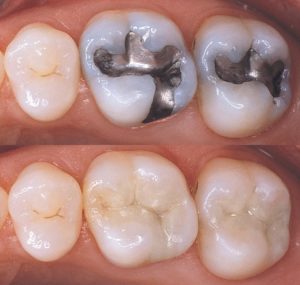
Cavities are common problems even today. The vast majority of Americans have had tooth decay. Fortunately, cavities aren’t typically difficult to deal with, especially if they’re detected and treated early. In many cases, treating cavities is easier with the help of tooth colored white fillings. White fillings not only blend in with your natural teeth, but they also reduce the risks of the cavity growing. If you have a cavity, then ask your dentist about white fillings. It might be your best option at saving your tooth.
Traditional Silver Fillings vs White Fillings
There are two primary reasons why patients sometimes choose resin over traditional metal fillings:
- Silver or gold fillings are quite noticeable as they do not blend in with the surrounding tooth structure. Placing a silver filling on front teeth is not accepted by most patients.
- Many individuals have concerns that the mercury contained in dental amalgam fillings may be harmful to overall health.
In fact, many patients even ask to replace their old metal fillings with resin composite. In this article, we’ll explore amalgam vs composite fillings and discuss the pros and cons of each.
Are metal amalgam fillings dangerous?
The FDA and the American Dental Association have deemed amalgam fillings safe. There continue to be some concerns that amalgam is harmful to your health. The International Academy of Oral Medicine states that free organic mercury has been linked to several medical conditions, including:
- Alzheimer’s disease
- Chronic fatigue syndrome
- Kidney disease
- Parkinson’s disease
- Reproductive dysfunction
- And more
The mercury in amalgam is inorganic and is chemically bound to silver. It is unlikely that it is being distributed into your system. Even still, most dentists have limited use of silver fillings selecting white fillings instead.
Other Side Effects of Traditional Metal Fillings
In addition to the general health concerns mentioned above, traditional metal fillings also pose some oral health concerns. For instance, amalgam is comprised of mercury, silver, tin copper, and zinc. It expands and contracts, especially when eating or drinking hot or cold foods or beverages. Over time, this could cause small hairline fractures in the surrounding tooth structure.
Furthermore, amalgam fillings require more removal of natural tooth structure. In other words, the treatment is more invasive compared to cavity repair with composite material.
Lastly, metal fillings are more likely to cause heat and cold sensitivity. It’s important to note, however, that temporary discomfort is to be expected after a filling is placed. Generally, however, these side effects subside quicker when white fillings are placed.
What are white fillings made of?
They are made from resin, which is comprised of finely ground particles of BPA-free acrylic and quartz. This is the same resin used for cosmetic tooth bonding. This gives your filling a highly lifelike appearance.
How does a dental filling stop further decay?
A tooth colored resin filling will restore your tooth’s strength and prevent cavities in the future. It does this by preventing oral bacteria from re-entering the tooth. Composite resin achieves this better than metal because it can be bonded more securely to your tooth’s structure.

Other benefits of tooth colored fillings
When compared to their traditional amalgam counterparts, white fillings offer a wide range of benefits. For example:
- Resin fillings are a good choice because they don’t require removal of much of your natural tooth structure. As a result, more healthy tissue can remain intact.
- While metal expands and contracts with temperature changes, white ones do not. Therefore, they actually strengthen and restore teeth more effectively.
- As aforementioned, patients report less post treatment sensitivity and discomfort with resin as with metal types of fillings.
- Tooth colored fillings improve oral health without detracting from the appearance of your smile.
Are there risks or side effects from white fillings?
Composite resin is not currently know to pose any health risks. However, like any dental care procedure, most patients feel some degree of temporary discomfort following treatment. Additionally, heightened sensitivity to heat and cold is more common in the few weeks after the procedure. These side effects usually diminish within a few weeks.
What is the procedure like?
When your white filling is being done due to decay, an x-ray of the affected tooth is suggested. This will allow Dr. Fondriest to determine the extent of the damage. Next, he will carefully remove any decayed or damaged portions of the tooth. This may be performed with a dental handpiece. Once this step is complete, there will be a void left in the tooth. This void is then filled with composite resin material. After shaping the material, it is then hardened with a special curing light. Finally, Dr. Fondriest checks your bite and makes any necessary final adjustments. Dental insurance plans tend to pay a portion of fillings.
